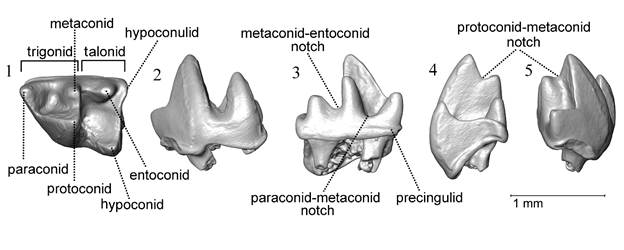Scientists spot fossils of a new genus of Treeshrew from Ramnagar in J&K

Sivatupaia ramnagarensis n. gen. n. sp., WIMF/A 4699 (holotype). 3D surface renderings of tooth in: (1) occlusal; (2) buccal; (3) lingual; (4) posterior; (5) anterior views.
Neeraj Bhatia
Scientists have spotted the fossils of Treeshrew, a small mammal resembling Squirrels, belonging to a new genus and species from Ramnagar in Jammu and Kashmir. This Treeshrew currently represents the oldest record of fossil Tupaiids in the Siwaliks, extending their time range by 2.5–4.0 million years in the region and can help provide a more precise age estimate for this Ramnagar locality lying in the Udhampur District (UT-Jammu & Kashmir). The newly described specimens are housed in the repository of Wadia Institute of Himalayan Geology, Dehradun, Uttarakhand.
Siwalik sediments document the evolution of many mammalian groups from the middle Miocene through Pleistocene, including Treeshrews, Hedgehogs, and other small mammals. Treeshrews, in particular, are very rare elements of the fossil record, with only a few species known throughout the entire Cenozoic era.
Scientists from the Wadia Institute of Himalayan Geology (WIHG), an autonomous institute of Department of Science and Technology (DST), found fossils of the new genus and species of Treeshrew (known as Sivatupaia ramnagarensis) from the middle Miocene (extends from about 23.03 to 5.333 million years ago) site of Ramnagar in Jammu and Kashmir.
Dietary analyses suggest that the new Tupaiid was probably adapted for a less mechanically challenging or more fruit eating diet compared to other extant and fossil Tupaiids. In addition, new hedgehog and rodent specimens have been described from this same fossil locality. The murine rodents are of particular importance, because different species and dental features are well-known to be time sensitive, as has been documented throughout a continuous, time-controlled Siwalik sequence on the Potwar Plateau of Pakistan. Therefore, the identification of these time sensitive dental features and species in the current collection help to provide a more precise age estimate for this Ramnagar locality as between 12.7-11.6 million years.
The work was carried out by Dr Ramesh Kumar Sehgal (leading author), Dr Ningthoujam Premjit Singh (corresponding author) and Abhishek Pratap Singh from Wadia Institute of Himalayan Geology, Dehradun, India in association with researches from Panjab University Chandigarh (Dr Rajeev Patnaik); Hunter College of the City University of New York, USA (Dr Christopher C Gilbert); University of Southern California, Los Angeles (Dr Biren A Patel); Arizona State University, USA (Dr Christopher J Campisano); American Museum of Natural History, USA (Dr Keegan R. Selig).
The study has been published in the Journal of Paleontology.

